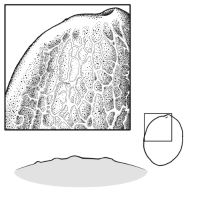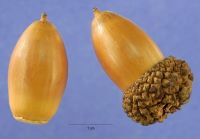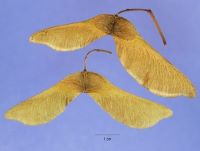Content is from Kirkbride et al. 2006Kirkbride et al. 2006:
Kirkbride JH, Jr, Gunn CR, and Dallwitz MJ. 2006. Family guide for fruits and seeds, vers. 1.0. Accessed September 2020-January 2022. URL: https://nt.ars-grin.gov/seedsfruits/keys/frsdfam/index.cfm ., without modification.
Updates are forthcoming.
Fruits: Pistil(s) 1; 1-pistillate. Fruit anthocarpanthocarp:
simple or compound and including some tissue of non-ovarian origin (accessory tissue) ; simple; Engelhardia pseudosamara, or pseudodrupe (Juglans Spjut Fig. 44A-B), or tryma (Carya Spjut Fig. 52A-B) & 3 families: Arecaceae, Juglandaceae, Thymelaeaceae); without persistent central column; with styles(s); at apexapex:
; simple; Engelhardia pseudosamara, or pseudodrupe (Juglans Spjut Fig. 44A-B), or tryma (Carya Spjut Fig. 52A-B) & 3 families: Arecaceae, Juglandaceae, Thymelaeaceae); without persistent central column; with styles(s); at apexapex:
the point farthest from the point of attachment, or the "tip" of an organ ; within accessory organ(s), or not within accessory organ(s); within involucreinvolucre:
; within accessory organ(s), or not within accessory organ(s); within involucreinvolucre:
in the grasses, a whorl or cluster of bracts or bristles subtending a floret or spikelet (bracts); accrescentaccrescent:
(bracts); accrescentaccrescent:
growing continuously
; persistent; 1-seeded; 1-seeded; with 2(–3)-carpellate; with carpels united; with carpels remaining united at maturity; with carpels remaining connected at stylestyle:
in a flower, the narrow and elongated part of the pistil between the stigma and the ovary; sometimes persisting in fruit ; without sterilesterile:
; without sterilesterile:
lacking male and/or female reproductive parts; also, not producing fruit or seed
 carpels; not sulcatesulcate:
carpels; not sulcatesulcate:
surface relief—having one or more elongate, relatively narrow and shallow depressions or grooves ; in transection tereteterete:
; in transection tereteterete:
approximately circular in cross section; width and thickness approximately equal
 , or flat, or compressedcompressed:
, or flat, or compressedcompressed:
flattened; in grasses, used to denote compression (not necessarily flattened) either laterally or dorsiventrally
; apexapex:
the point farthest from the point of attachment, or the "tip" of an organ not beaked; indehiscentindehiscent:
not beaked; indehiscentindehiscent:
not opening on its own, as in a fruit
 , or dehiscentdehiscent:
, or dehiscentdehiscent:
(v. dehisce) splitting open at maturity to release contents (of a fruit) . Dehiscentdehiscent:
. Dehiscentdehiscent:
(v. dehisce) splitting open at maturity to release contents (of a fruit) unit "fruit" (Carya). Dehiscentdehiscent:
unit "fruit" (Carya). Dehiscentdehiscent:
(v. dehisce) splitting open at maturity to release contents (of a fruit) without replumreplum:
without replumreplum:
the rim, formed by the persistent placentas, and connected by a false septum in Brassicaceae fruits. The fruit valves are attached to this rim and separate from it in dehiscent fruits.
. Epicarpepicarp:
outer layer of fruit wall or pericarp, if divided into layers; note here used synonymously with exocarp black, or brown (all shades), or green; dulldull:
black, or brown (all shades), or green; dulldull:
reflecting only a low proportion of incident light, with no apparent sheen , or shinyshiny:
, or shinyshiny:
uniformly reflecting a high proportion of incident light at all angles ; durable; hard; glabrousglabrous:
; durable; hard; glabrousglabrous:
without hairs
, or not glabrousglabrous:
without hairs
(with hairs) (hispid Alfaroa); hairs not glandularglandular:
surface relief—covered with small, raised secretory glands, regular or irregularly shaped, translucent or opaque, and maybe distinctly colored ; without armature; smooth, or not smooth; ridgedridged:
; without armature; smooth, or not smooth; ridgedridged:
surface relief—raised, thick ridges, sharp edged or rounded, usually in a series that may cover the entire surface , or rugoserugose:
, or rugoserugose:
wrinkled ; without wing(s), or with wing(s); 1–2–3-winged; with wing(s) apicalapical:
; without wing(s), or with wing(s); 1–2–3-winged; with wing(s) apicalapical:
at or pertaining to the end of the seed or fruit distal from its point of attachment (i.e., base)
, or encompassing (Cyclocarpa); without apicalapical:
at or pertaining to the end of the seed or fruit distal from its point of attachment (i.e., base)
respiratory hole. Mesocarpmesocarp:
the middle layer of the pericarp, if divided into layers present; fleshy; composed of 1 unified layer; without lactiform cavity system. Endocarpendocarp:
present; fleshy; composed of 1 unified layer; without lactiform cavity system. Endocarpendocarp:
the inner layer of the pericarp, if divided into layers present; not separating from exocarpexocarp:
present; not separating from exocarpexocarp:
outer layer of fruit wall or pericarp, if divided into layers; note here used synonymously with epicarp ; thin; not splitting into 1-seeded pyrenes; not smooth; with ridges; without wing; without operculumoperculum:
; thin; not splitting into 1-seeded pyrenes; not smooth; with ridges; without wing; without operculumoperculum:
a dehiscent cap (or lid) of a seed or fruit that opens during germination or dehiscence ; without secretory cavities; without grooves; with longitudinallongitudinal:
; without secretory cavities; without grooves; with longitudinallongitudinal:
of or relating to length or the lengthwise dimension
ridges, or without longitudinallongitudinal:
of or relating to length or the lengthwise dimension
ridges; without fracturing longitudinallongitudinal:
of or relating to length or the lengthwise dimension
ridges. Funiculusfuniculus:
(alt. funicle) stalk connecting the ovule (later seed) to the ovary (later fruit) placenta short; short without seed bearing hookswith hooks:
short; short without seed bearing hookswith hooks:
bristles or spines with curved or backwards pointing tips, or with secondary bristles along their length (retinacula); not persisting in fruit after seed shed.
(retinacula); not persisting in fruit after seed shed.
Seeds: Arilaril:
(broad sense) appendicular structure that wholly or partly envelops a seed and is produced from or a modification of the funicle, raphe, or outer integument; usually fleshy or pulpy, sometimes spongy or tufted-capillate, often brightly colored absent. Seed larger than minute; cerebriformcerebriform:
absent. Seed larger than minute; cerebriformcerebriform:
an irregular brain-like appearance, as the kernel of a walnut
; not bowl shaped; not nutlike; without winglike beakbeak:
a usually firm, terminal appendage, sometimes tapered ; without caudatecaudate:
; without caudatecaudate:
tapering to a long, tail-like appendage appendage(s); at maturity without food reserves, or without apparent food reserves, or with food reserves; with endosperm; without canavanine. Sarcotestasarcotesta:
appendage(s); at maturity without food reserves, or without apparent food reserves, or with food reserves; with endosperm; without canavanine. Sarcotestasarcotesta:
pulpy or fleshy outer layer of the seed coat, simulates aril absent. Testatesta:
absent. Testatesta:
seed coat
 present; without markedly different marginalmarginal:
present; without markedly different marginalmarginal:
at, on, or close to the margin or border
tissue; without fleshy or leatheryleathery:
texture—moderately thick, tough, and very pliable
layer over hard layer; tight; dulldull:
reflecting only a low proportion of incident light, with no apparent sheen ; surface unsmooth, or smooth; surface with merged raised features; surface sculptured, or veinedveined:
; surface unsmooth, or smooth; surface with merged raised features; surface sculptured, or veinedveined:
surface relief—lines that intersect in a vein pattern that is flush or slightly raised from the surface ; without crease or line separating cotyledons from hypocotyl-radicle; without notch along margin where cotyledons from hypocotyl-radicle tip approach each other; without glands; without bristles; glabrousglabrous:
; without crease or line separating cotyledons from hypocotyl-radicle; without notch along margin where cotyledons from hypocotyl-radicle tip approach each other; without glands; without bristles; glabrousglabrous:
without hairs
; without wings; without collar; without operculumoperculum:
a dehiscent cap (or lid) of a seed or fruit that opens during germination or dehiscence ; colored; monochrome; brown (all shades); thin; not becoming mucilaginousmucilaginous:
; colored; monochrome; brown (all shades); thin; not becoming mucilaginousmucilaginous:
resembling mucilage; moist and sticky
when wetted; surrounding embryo. Hilumhilum:
on seeds, the scar indicating where the funiculus was attached; on grass caryopses, the scar visible on the outer fruit surface revealing where the seed is attached on the inner fruit wall surface; or in Asteraceae cypselae, the scar visible on the outer fruit wall revealing where the fruit was attached to the receptacle punctate (assumed). Endosperm development nuclear; trace (single layer for Carya & Juglans); without fatty acid containing cyclopropene; without apicalapical:
punctate (assumed). Endosperm development nuclear; trace (single layer for Carya & Juglans); without fatty acid containing cyclopropene; without apicalapical:
at or pertaining to the end of the seed or fruit distal from its point of attachment (i.e., base)
lobes; without chlorophyll; without isodiametric faceted surface; without odor. Embryo differentiated from food reserve; well developed; 1 per seed; completely filling testatesta:
seed coat
 (no food reserve); at one end of seed not extending into a depression or cup; foliatefoliate:
(no food reserve); at one end of seed not extending into a depression or cup; foliatefoliate:
appearing leaf-like
; with investinginvesting:
(of embryo) embryo is nearly or completely filling seed coat, straight, and axile and centric with spatulate cotyledons and covering the stalk for at least half its length; (of cotyledons) cotyledons spatulate and covering the stalk for at least half its length
cotyledons; straight; parallel to seed length; with cotyledons abruptly connected to hypocotyl-radicle; without coleorhiza; without simmondsin; with cotyledons containing oils; without stomata; not green; with 2 or more cotyledons. Cotyledons 2; well developed; not divaricate; 0.75–1 times length of embryo; somewhat to significantly wider than hypocotyl-radicle; unknown, but in some cases quite large; partially concealing hypocotyl-radicle (at least); massive, or thin; much contorted, or crumpled, or once-folded (at least the apicesapex:
the point farthest from the point of attachment, or the "tip" of an organ in Engelhardtia & Pterocarya); sculptured; with Mesocarpmesocarp:
in Engelhardtia & Pterocarya); sculptured; with Mesocarpmesocarp:
the middle layer of the pericarp, if divided into layers - lobed; with margins separate; basally cordatecordate:
- lobed; with margins separate; basally cordatecordate:
2D shape—heart-shaped, with attachment at or near the broad end (compare obcordate) ; equal in size; not punctatepunctate:
; equal in size; not punctatepunctate:
surface relief—dotted with pits or with translucent, sunken glands or with colored dots, similar to pitted dotted. Hypocotyl-radicle small; straight; not thickened. Plumule well developed; composed of 2 seed-leaves.
dotted. Hypocotyl-radicle small; straight; not thickened. Plumule well developed; composed of 2 seed-leaves.
 or samarasamara:
or samarasamara: , or drupelike (tryma), the soft husk (involucreinvolucre:
, or drupelike (tryma), the soft husk (involucreinvolucre: ) slipping to release the bonybony:
) slipping to release the bonybony: bracts?
bracts?
Literature specific to this family: Stone. D.E. 1989. Biology and evolution of temperate and tropical Juglandaceae. In: P.R Crane & S. Blackmore, eds., Evolution, systematics, and fossil history of the Hamamelidae. Vol. 2: 'Higher' Hamamelidae. Syst. Assoc. Special Vol. 40B, pp.117–145. Clarendon Press, Oxford.
General references: Corner, E.J.H. 1976. The seeds of Dicots, esp. vol. 2. Cambridge University Press, New York, Cronquist, A. 1981. An integrated system of classification of flowering plants, 1,262 p. Columbia University Press, New York, Gaertner, J. 1788–1805. De fructibus et seminibus plantarum. The Author, Stuttgart, Goldberg, A. 1986 (dicots) & 1989 (monocots). Classification, evolution, and phylogeny of the familes of Dicotyledons. Smithsonian Contr. Bot. 58 for dicots (314 pp.) & 71 for monocots (74 pp.). [Goldberg's illustrations are reproduced from older publications and these should be consulted], Gunn, C.R., J.H. Wiersema, C.A. Ritchie, & J.H. Kirkbride, Jr. 1992 & amendments. Families and genera of Spermatophytes recognized by the Agricultural Research Service. Techn. Bull. U.S.D.A. 1796:1–500, Mabberley, D.J. 1987. The plant-book, 706 p. Cambridge University Press, Cambridge, Schopmeyer, C.S. 1974. Seeds of Woodywoody:
texture—consisting mainly of indurate lignified tissues, characteristic of or resembling wood
plants in the United States. Agric. Handb. 450:1–883, Spjut, R.W. 1994. A systematic treatment of fruit types. Mem. New York Bot. Gard. 70:1–182, and Wood, C.E., Jr. 1974. A student's atlas of flowering plants: Some dicotyledons of eastern North America, 120 pp. Harper & Row, New York.